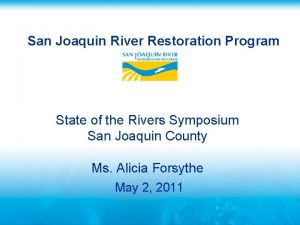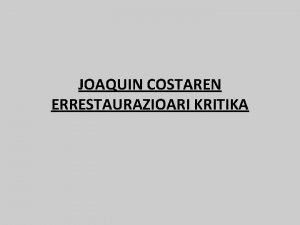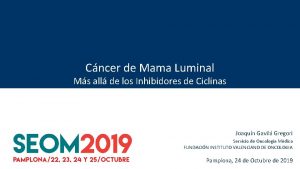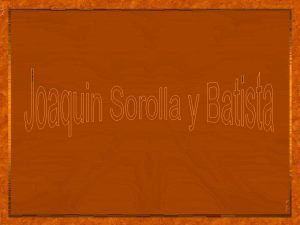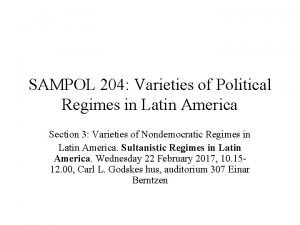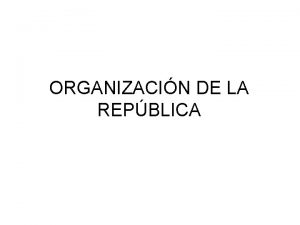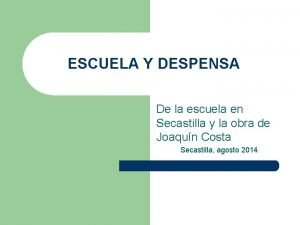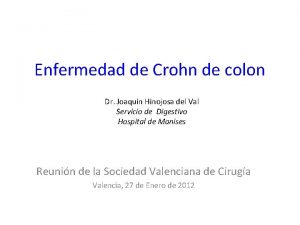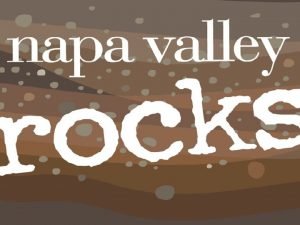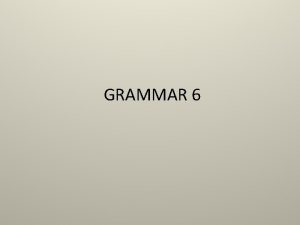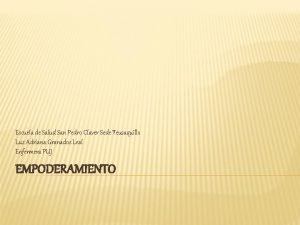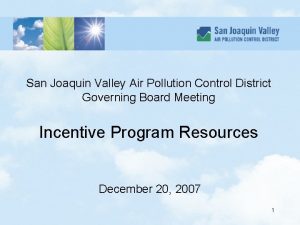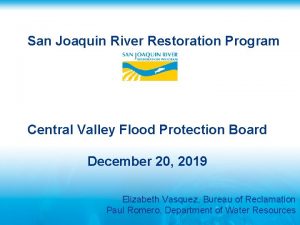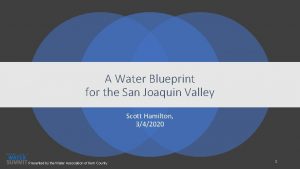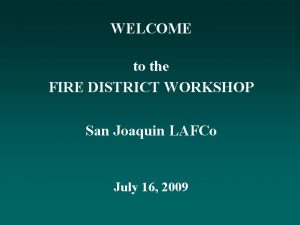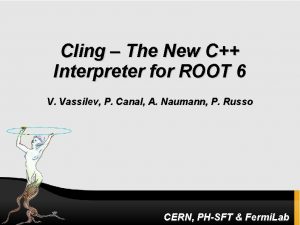Welcome to the North San Joaquin Valley Cling
































































- Slides: 64

Welcome to the North San Joaquin Valley Cling Peach Day Sponsored by UC Cooperative Extension & the California Cling Peach Board

Fertilization Guidelines for Peaches Roger Duncan Pomology & Viticulture Advisor University of California Cooperative Extension Stanislaus County

Today we will discuss: • Nitrogen • Phosphorus • Potassium • Zinc

A good fertility program is based on: • Replacing what is removed with the crop – shouldn’t be based on “what I always do” • Monitoring long term trends with annual tissue samples • Occasional soil samples for gradual changes in soil chemistry. • Yield is already affected by the time you see symptoms

Nitrogen Deficiency • Mild deficiency: lack of growth, smaller, pale green leaves with red tinge • N is mobile, shows in old and new leaves

Nitrogen Deficiency • As deficiency worsens, leaves get yellower and smaller • May develop red spots

Nitrogen Deficiency • Lower N favors good color in fresh market fruit

Crop load drives demand for N: • Between 2 – 3 pounds of N removed with every ton of peaches • Perennial structure requires additional ~ 20 lb. per acre – More in high density orchards • Leaves & prunings ~ 60 lb. (80 -90% recycled)

Approximate N fertilizer requirements for mature peach and nectarine orchards. • • • Assumes that prunings are not removed from the orchard 2. 69 lbs. N are removed per ton yield 19 lb for perennial part of tree 90% recycle of leaves & prunings (~ 9 pounds) N use efficiency is 70% Yield (tons / acre) 6 12 18 24 30 N (lb / acre) 63 86 109 132 155

Excessive N Fertilization Leads to: • • Excessive shoot growth Increased (summer) pruning costs Excessive shading of lower wood Shorter orchard lifespan More brown rot Poor coloration and delayed harvest (fresh market) Potential ground water contamination Regulations

Leaf sampling procedure: • June – July • Sample each variety / block separately • Weaker or “different” areas of a block should be sampled separately

Leaf sampling procedure: • 60 – 100 mid shoot leaves from current season shoots. • Leaves treated with foliar zinc are not useful to determine zinc status • Trees sprayed with N should not be sampled for at least one week • Analyze promptly or refrigerate

Dormant Shoot Sampling: • July sampled leaves too late for current season adjustment and for zinc contamination • Sample 30 – 40 moderately vigorous shoots 10 -20 inches long from lower canopy. • Guidelines are for January but fall may give similar results

UC Guidelines for Nitrogen in July. Sampled Leaves and Dormant Shoots July Leaf (%) Deficient Adequate Excessive Fresh Market < 2. 3 2. 4 – 3. 0 > 3. 0 Processing < 2. 4 2. 6 – 3. 5 > 3. 5 Dormant Shoot (%) 1. 2

Nitrogen Fertilizers: • Trees don’t care – N is taken up as nitrate whether organic or inorganic • Nitrate very mobile in soil, leachable • Ammonium less mobile but converted to NO 3 within days at warm temps – Nitrification; acidifies soil • Urea converted to ammonium, will volatilize quickly on soil surface

Time of Nitrogen Fertilizer Application: • Trees take up almost no nitrogen when leaves are absent. • Nitrogen for spring growth comes from N stored in roots, trunk, shoots. • Nitrogen applied before leaf out is susceptible to loss by leaching and volatilization.

Time of Nitrogen Fertilizer Application: • Peaches relatively low users of nitrogen compared to almonds so don’t need to “front load” so much. • Extra earlies (especially May – June fresh market peaches) – Too much N early leads to excessive growth after harvest, poor quality – Late summer applications might be good strategy • Provides N for next year’s crop without excessive post-harvest growth – Foliar urea in fall

Foliar Nitrogen Application: • Studies show that 20 – 50% of N can be supplied through the leaves • Urea is cheapest and mostly easily absorbed into the leaf • Up to 50 lbs. of N / acre (100 lbs. urea) can be sprayed per application • Multiple applications OK two weeks apart

Foliar Nitrogen Application: • When to spray • October – Before natural leaf senescence – September too soon due to earlier defoliation • If combined with zinc, more N (and Zn) mobilized into storage than if applied alone

Phosphorus • P deficiency is very rare in California • Most soils contain a lot of P, most is in unavailable form

Phosphorus Deficiency • Lack of spring growth

Phosphorus Deficiency • Reddening of new growth in spring • More mature leaves can be darker green than normal

Phosphorus Deficiency • Phosphorus deficient leaves turn purple in fall

Phosphorus Deficiency • Branches can defoliate and collapse under severe deficiency

Phosphorus Deficiency • Some varieties may crack under severe P deficiency

UC Guidelines for Phosphorus in July. Sampled Leaves and Dormant Shoots Deficient Adequate July Leaf (%) < 0. 12* 0. 12 – 0. 3 Excessive > 0. 4 Dormant Shoot (%) 1. 1 *Previous literature cited 0. 10% P as adequate for leaves

Phosphorus Fertilization: • Very rarely needed in California peaches • 0. 5 – 1. 0 lb. P 2 O 5 removed per ton of fruit – 10 – 20 lb. P 205 in a 20 ton crop • P is very immobile in soil. Cannot be leached with irrigation or rain. Therefore timing is not important. • Usually drilled 6 -8 inches deep • If fertigated by drip, be careful not plug with calcium phosphate precipitate

Phosphorus Fertilization: • Side note – phosphorous acid materials (phosphites) do not supply tree with P • Good for Phytophthora management, not as a P fertilizer

Potassium (a. k. a. Potash) • More potassium removed than N • Can influence fruit size • Might be neglected more than it should be

Potassium (a. k. a. Potash) • Deficiency usually first seen in early summer • Potassium deficient leaves tend to roll at the edges – Midshoot leaves affected most

Potassium Deficiency • Leaves may also be a little pale. Margins may scorch

Potassium Deficiency • Fruit set, shoot growth and leaf size is reduced • Fruit size and color are reduced • *Fruit size can be reduced before other signs are obvious

Potassium Deficiency • Severe potassium deficiency can lead to defoliation and limb death

UC Guidelines for Potassium in -Sampled Leaves Deficient Adequate July Leaf (%) < 1. 0 > 1. 2* July Dormant Shoot (%) ? Excessive *Probably should be > 1. 5% K to ensure that the majority of trees are over 1. 2%

Potassium Fertilization: • Average of 4 – 5 lb. K 2 O (3. 3 – 4. 2 lb. K) removed per ton of fruit • = 80 – 100 lb. K 2 O in 20 ton yield

Potassium Fertilizers: • Potassium can be tightly bound to clay particles so generally we apply high quantities in concentrated applications to overcome problem • Less of an issue in sandy soil or where active roots are very shallow – Drip or microsprinklers • Adding gypsum (Ca. SO 4) can help K move deeper in soil

Potassium Fertilizers: • Potassium chloride (KCl) • Probably cheapest form per pound of K 2 O but risky due to Cl component • Should be applied after leaf drop in fall • Sulfate of potash (K 2 SO 4) – More expensive than KCl but safer – Not soluble but can be applied through solutionizer – May be able to broadcast in sandy soil under microsprinkler

Potassium Fertilizers: • If banding sulfate of potash (K 2 SO 4) in drip-irrigated orchard, drip hose must be placed over band

Potassium Fertilizers: • Potassium nitrate (KNO 3) – Also supplies N which should be accounted for – Can be applied as foliar spray – Foliar KNO 3 applied during stage III may be effective – high demand period – May require multiple sprays at 40 lb to correct deficiency • Potassium thiosulfate (KTS 0 -0 -25) – Efficiently applied with fertigation but more expensive

Zinc - Influences on Deficiency: • Soil p. H – Zn availability decreases over p. H 6. 0 • Lime (calcium carbonate) ties up zinc. Magnesium carbonate is worse • Land leveling - zinc content decreases with soil depth. • High amounts of phosphorus (ties up zinc)

Zinc - Influences on Deficiency: • Organic matter and manure – Zinc is less available in soils with a high OM content. – Heavy manure - chicken manure is particularly bad • High levels of other metallic elements (copper, iron, manganese) can induce zinc deficiency • Cool, wet soils • Rootstock (nemaguard is bad)

Zinc Deficiency • Interveinal yellowing with mild zinc deficiency

Zinc Deficiency Very small, pale, pointy leaves in a rosette (very short space between leaves) with more severe zinc deficiency

Zinc Deficiency Extreme deficiency looks like glyphosate damage

UC Guidelines for Zinc in July-Sampled Leaves and Dormant Shoots Deficient July Leaf (ppm)1 Dormant Shoot (ppm) < 152 < 15 1 Leaf samples are not reliable if orchard has been previously sprayed with zinc 2 Recent experiments indicate that a threshold of 10 ppm zinc is more appropriate for July-sampled leaves

Foliar Applications of Zinc

Zinc Materials Basic Chemicals • Zn sulfate • Zn oxide • Zn carbonate • Zn chloride • Zn oxysulfate • Zn nitrate Chelates & Complexes • EDTA • Lignosulfonate • Amino acid • Sugar • Citric acid • Fulvic acid, humic acid

Zinc Materials Zinc Sulfate (35% Zn) • Inexpensive • Very soluble • Widely used • Considered to be effective • Can be phytotoxic

Zinc Materials Basic or Neutral Zinc • Cost = 2 x Zn sulfate • Mostly insoluble • Widely used • Considered to be effective • Not phytotoxic • Can be mixed with oil

Zinc Materials Amino Acid Complexes • Expensive • Considered to be effective • Can be phytotoxic • 6 to 7% zinc

Zinc Materials Zinc Chelates • Not cheap • Usually EDTA • Low phytotoxicity • 7 to 9% zinc

Zinc Sulfate Damage Sprayed in April at 1000 ppm (2 lb)

Fruit Damage from Zinc Sprays

Leaf & Fruit Damage on Peach, Plum and Apricot Trees Sprayed in April with Different Formulations of Zn at 1, 000 ppm Nitrate EDTA A. A. Complex Lignosulfonate Sulfate Fulvic Fruit damage Leaf damage Neutral -52% Control 0 1 2 3 Damage Rating 4 5


Zinc Formulations Applied Foliarly to Peach Seedlings Leaf Area on Lateral Shoots 300 a a 250 200 b b b Leaf Area 150 2 (cm ) 100 b c 50 0 UTC SO 4 Zn to Roots O + SO 4 EDTA Treatment Polyamine Leonardite

Comparing Zinc Formulations Most Effective = Nitrate (Patrick’s mix) Sulfate – 36% Carbohydrate (Zicron) Polyamine EDTA Leonardite Oxysulfate – 52% Least Effective = Zn. O Suspension

Strategies with Zinc Sulfate (Timing, Rate, etc) 1. Spring – Phytotoxicity concerns 2. All Season – Low rate 3. Fall or Dormant

Strategies with Zinc Sulfate (Timing, Rate, etc) 1. Spring – Phytotoxicity concerns Zn Oxide or Neutral Zn? 2. All Season – Low rate 3. Fall or Dormant

Strategies with Zinc Sulfate (Timing, Rate, etc) 1. Spring – Phytotoxicity concerns Zn Oxide or Neutral Zn? 2. All Season – Low rate Efficiency? 3. Fall or Dormant

Strategies with Zinc Sulfate (Timing, Rate, etc) 1. Spring – Phytotoxicity concerns Zn Oxide or Neutral Zn? 2. All Season – Low rate Efficiency? 3. Fall or Dormant Early fall better than late fall Use rate that doesn’t defoliate quickly

Strategies with Zinc Sulfate (Timing, Rate, etc) 1. Spring – Phytotoxicity concerns Zn Oxide or Neutral Zn? 2. All Season – Low rate Efficiency? 3. Fall or Dormant Early fall better than late fall Use rate that doesn’t defoliate quickly Fall better than dormant

Zinc Conversions (Approximate) Zn Concentration (ppm) 100 200 300 400 500 1, 000 2, 000 5, 000 10, 000 Zn Sulfate/100 gals (lbs) 36% Zn Zn EDTA/100 gals (qrts/ gals) 9% Zn Zn Metalosate/100 (gals) 6. 8% Zn 0. 2 0. 5 0. 7 0. 9 1 2 5 12 23 1/3 qt 2/3 qt 1/3 gal ½ gal 1 gal 2 gals 4 gals 8 gals 1 pint 1 qt 3 pints ½ gal 5 qts 2. 5 gals

Cost of Zinc Materials - October 2007 Zn Metalosate 6. 8% Zn Fulvic 10% N Zn Zn Leonardite Zn EDTA $33. 51 $17. 01 5% $16. 51 6. 5% $15. 19 9% $12. 88 Zn Ligno-Sulfonate 7% Zn. O Suspension 40% Neutral Zn 52% Zn Sulfate 36% Zn Oxide 80% $9. 15 $7. 55 $4. 12 $2. 22 $1. 15 0 10 20 30 40
 Subsidence san joaquin valley
Subsidence san joaquin valley San joaquin county electric vehicle rebate
San joaquin county electric vehicle rebate San joaquin river restoration program
San joaquin river restoration program San joaquin delta college notable alumni
San joaquin delta college notable alumni San joaquin county redistricting
San joaquin county redistricting San joaquin river exchange contractors water authority
San joaquin river exchange contractors water authority Carlos fajardo casajús.
Carlos fajardo casajús. Joaquin costaren testuaren iruzkina
Joaquin costaren testuaren iruzkina Venetoclast
Venetoclast Robin andresen
Robin andresen Joaquin sorolla y batista
Joaquin sorolla y batista Emotional or subjective acting
Emotional or subjective acting Joaquin balaguer
Joaquin balaguer Jose joaquin prieto
Jose joaquin prieto Joaquin prieto
Joaquin prieto Escuela y despensa joaquin costa
Escuela y despensa joaquin costa Joaquín hinojosa
Joaquín hinojosa Joaquin lado
Joaquin lado Distancia entre san francisco y napa valley
Distancia entre san francisco y napa valley True north vs magnetic north
True north vs magnetic north North east and north cumbria ics map
North east and north cumbria ics map North and south lesson 3 southern cotton kingdom
North and south lesson 3 southern cotton kingdom The north pole ____ a latitude of 90 degrees north
The north pole ____ a latitude of 90 degrees north Wise men three clever are we
Wise men three clever are we San diego continuing education north city campus
San diego continuing education north city campus 49 san jacinto houston tx
49 san jacinto houston tx Usf sacramento campus
Usf sacramento campus Qué opinas acerca de san pedro y san pablo
Qué opinas acerca de san pedro y san pablo I c san giovanni bosco
I c san giovanni bosco Esspc
Esspc Hát kết hợp bộ gõ cơ thể
Hát kết hợp bộ gõ cơ thể Frameset trong html5
Frameset trong html5 Bổ thể
Bổ thể Tỉ lệ cơ thể trẻ em
Tỉ lệ cơ thể trẻ em Voi kéo gỗ như thế nào
Voi kéo gỗ như thế nào Glasgow thang điểm
Glasgow thang điểm Chúa yêu trần thế alleluia
Chúa yêu trần thế alleluia Các môn thể thao bắt đầu bằng tiếng chạy
Các môn thể thao bắt đầu bằng tiếng chạy Thế nào là hệ số cao nhất
Thế nào là hệ số cao nhất Các châu lục và đại dương trên thế giới
Các châu lục và đại dương trên thế giới Công của trọng lực
Công của trọng lực Trời xanh đây là của chúng ta thể thơ
Trời xanh đây là của chúng ta thể thơ Cách giải mật thư tọa độ
Cách giải mật thư tọa độ 101012 bằng
101012 bằng độ dài liên kết
độ dài liên kết Các châu lục và đại dương trên thế giới
Các châu lục và đại dương trên thế giới Thể thơ truyền thống
Thể thơ truyền thống Quá trình desamine hóa có thể tạo ra
Quá trình desamine hóa có thể tạo ra Một số thể thơ truyền thống
Một số thể thơ truyền thống Cái miệng nó xinh thế chỉ nói điều hay thôi
Cái miệng nó xinh thế chỉ nói điều hay thôi Vẽ hình chiếu vuông góc của vật thể sau
Vẽ hình chiếu vuông góc của vật thể sau Thế nào là sự mỏi cơ
Thế nào là sự mỏi cơ đặc điểm cơ thể của người tối cổ
đặc điểm cơ thể của người tối cổ Thế nào là giọng cùng tên
Thế nào là giọng cùng tên Vẽ hình chiếu đứng bằng cạnh của vật thể
Vẽ hình chiếu đứng bằng cạnh của vật thể Vẽ hình chiếu vuông góc của vật thể sau
Vẽ hình chiếu vuông góc của vật thể sau Thẻ vin
Thẻ vin đại từ thay thế
đại từ thay thế điện thế nghỉ
điện thế nghỉ Tư thế ngồi viết
Tư thế ngồi viết Diễn thế sinh thái là
Diễn thế sinh thái là Dạng đột biến một nhiễm là
Dạng đột biến một nhiễm là Các số nguyên tố
Các số nguyên tố Tư thế ngồi viết
Tư thế ngồi viết Lời thề hippocrates
Lời thề hippocrates


